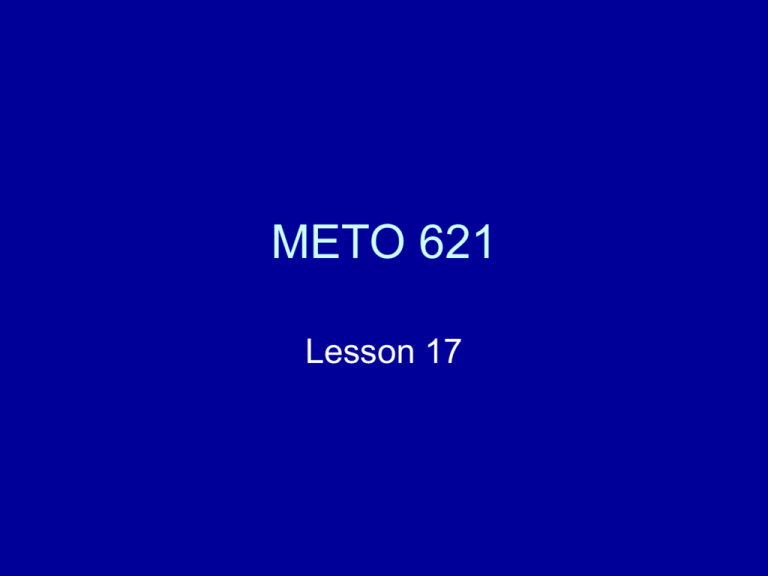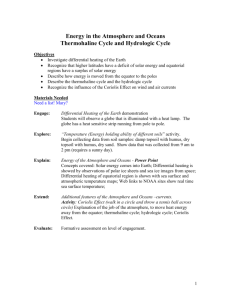Lesson17
advertisement

METO 621 Lesson 17 Heating rates in the Atmosphere • Assume that the Earth’s surface is a blackbody, and that the downward intensity at the top of the atmosphere is zero. Then we can write z dTF ( z, z ' ) * F ( z ) B TF ( z ,0) B( z ' ) dz ' 1 dz ' 0 zt dTF ( z , z ' ) F ( z ) B( z ' ) dz ' dz ' z 2 • If we examine equation 1, the integrand can be viewed as u.dv in the relation d(uv)=vdu+udv and can be replaced by dB(z' )TF ( z, z ' ) d B( z ' ) dz' - TF ( z, z ' )dz ' 0 dz ' dz ' 0 z z Heating rates in the Atmosphere which equals z B( z ) B(0)TF (z,0) - 0 d B( z ' ) TF ( z , z ' )dz ' dz ' and equation 1 becomes z F ( z ) B( z ) B* B(0) TF ( z ,0) 0 d B( z ' ) TF ( z , z ' )dz ' dz ' If we apply the same procedure to Equation 2 we get zt F (z) z dB(z" )TF (z,z" ) dz" dz" B(z) B(zt )TF (z,zt ) zt z zt z dB(z") TF (z,z")dz" dz" dB(z") TF (z,z")dz" dz" Heating rates in the Atmosphere The net flux Fnet F F will consist of four terms t d B( z ' ) d B( z ' ) TF ( z, z ' ) dz ' - TF ( z, z ' ) dz ' dz ' dz ' 0 z z z Fnet B( zt )TF ( z, zt ) B* B(0) TF ( z,0) At first glance it might seem that the first two terms can be combined into a single integral. The problem is that T(z,z’) has a discontinuity at z. Hence the two integrals cannot be combined Heating Rates Heating rates in the Atmosphere • The heating rate at z is defined as follows: dFnet ( z ) H ( z) dz and will consist of four terms dTF ( z , z ' ) d B( z ' ) H ( z) dz ' dz dz ' 0 A. dTF ( z , z ' ) d B( z ' ) dz ' dz dz ' z B. z zt dTF ( z , zt ) dz dTF ( z ,0) * B B(0) dz B( zt ) C. D. Heating rates in the Atmosphere • The term C is usually referred to as the ‘cooling to space’ term. Note that in terms A and B, the differential of TF is with respect to z and not z’. • We will now examine the contribution that each term makes to the heating and cooling of the atmosphere. dTF But first we must examine the sign of the term dz This term can be defined as follows : dTF TF ( z z , z ' ) TF ( z.z ' ) limit as z 0 dz z for any z ' greater th an z , TF ( z z , z ' ) TF ( z , z ' ) dTF and will be positive because the distance from dz ( z z ) to z ' is less than from z to z '. Hence T is greater. Heating rates in the Atmosphere • By similar arguments it can be shown that for z’ less than z, dT/dz will be negative • Now we will examine the four terms for three classes of atmosphere. • Isothermal • One with a nominal lapse rate • One with a temperature inversion Isothermal Atmosphere • For an isothermal atmosphere dB/dz will be zero. Hence the terms A and B are zero • In an isothermal atmosphere the temperature at the surface is equal to the temperature of the atmosphere directly above the surface, hence term D is zero • Term C is the only term that survives. dT/dz is positive (z’>z) and B is positive. The sign in front of the term is negative, hence the overall term is negative – cooling. • Term dB/dz’ dT/dz Sign overall A 0 + 0 B 0 + + 0 C + D 0 Nominal lapse rate • The temperature of the atmosphere decreases with z, hence dB/dz’ is negative. • The term dTF/dz is negative for A, positive for B and positive for D. The signs can be summarized as follows: Term dB/dz’ dT/dz sign overall sign A + + (heating) B + + - (cooling) C + - (cooling) D + (heating) Temperature inversion • Assume that z is at the inversion. dB/dz’ changes sign at z: Term db/dz’ dT/dz sign overall sign A + + - (cooling) B + + - (cooling) C + - (cooling) D + (heating) • Note that term A shows cooling, whereas for a nominal lapse rate it gave heating. The tendency of the atmosphere is to remove the inversion. Effect of clouds on the heating rate • Define two heating rates H0 (open sky) and Hc (opaque cloud). • Clouds of more than 300 meters thick are typically opaque in the thermal infrared. So one can treat clouds as blackbody radiators. • First consider the effect on the heating rate above a cloud, at a height zc • For the upward flux at z, the cloud at zc becomes the surface, and we can replace B* with B(zc) and term D will be zero. Effect of clouds on the heating rate dTF ( z , z ' ) d B( z ' ) H c ( z) dz ' dz dz ' zc A dTF ( z, z ' ) d B( z ' ) dz ' dz dz ' z B z zt dTF ( z, zt ) - B( zt ) dz Subtractin g H 0 from H c one gets zc H c ( z) H 0 ( z) 0 dTF ( z , z ' ) d B( z ' ) dz ' dz dz ' (B * B(0)) dTF ( z ,0) dz C Effect of clouds on the heating rate • For an isothermal atmosphere both terms go to zero, hence the heating rate above the cloud does not change. • For a nominal lapse rate, the first term is negative, dT/dz is negative, dB/dz is negative, and the sign is negative. The second term is also negative. Net effect of the cloud is to cool the atmosphere above the cloud. This can be quite large, and in some cases can lead to a steeper lapse rate, destabilizing the cloud. Effect of clouds on the heating rate • Now consider the effect of z below the cloud. • In the derivation of the four terms A,B,C and D, we assumed that the downwelling intensity at the top of the atmosphere was zero. • However below zc the cloud acts downward as a blackbody radiator, so this assumption is no longer true. Hence the terms are modified. • The full flux equation becomes: zc dTF ( z , z ' ) F ( z ) B( zc )TF ( z , zc ) B( z ' ) dz ' dz ' z Effect of clouds on the heating rate • As before, we integrate by parts and get d B( z ' ) F ( z ) B ( z ) TF ( z.z ' ) dz ' dz ' z zc The heating rate now consists of three terms (the cooling to space term dissapears ). dTF ( z , z ' ) d B( z ' ) H c ( z) dz ' dz dz ' 0 A dTF ( z , z ' ) d (B( z ' ) dz ' dz dz ' z B dTF ( z ,0) - (B * B(0)) dz D z zc Effect of clouds on the heating rate • The change in heating rate now becomes dTF ( z , z ' ) d B( z ' ) H c ( z) H 0 ( z) dz ' dz dz ' zc zt dTF ( z , zt ) B( zt ) dz • For an isothermal atmosphere the first term is zero. The second term is positive (B is positive, dT/dz is positive) hence clouds increase the heating rate below the cloud. • For a nominal lapse rate, both terms are positive. The heating rate is increased below the cloud.






